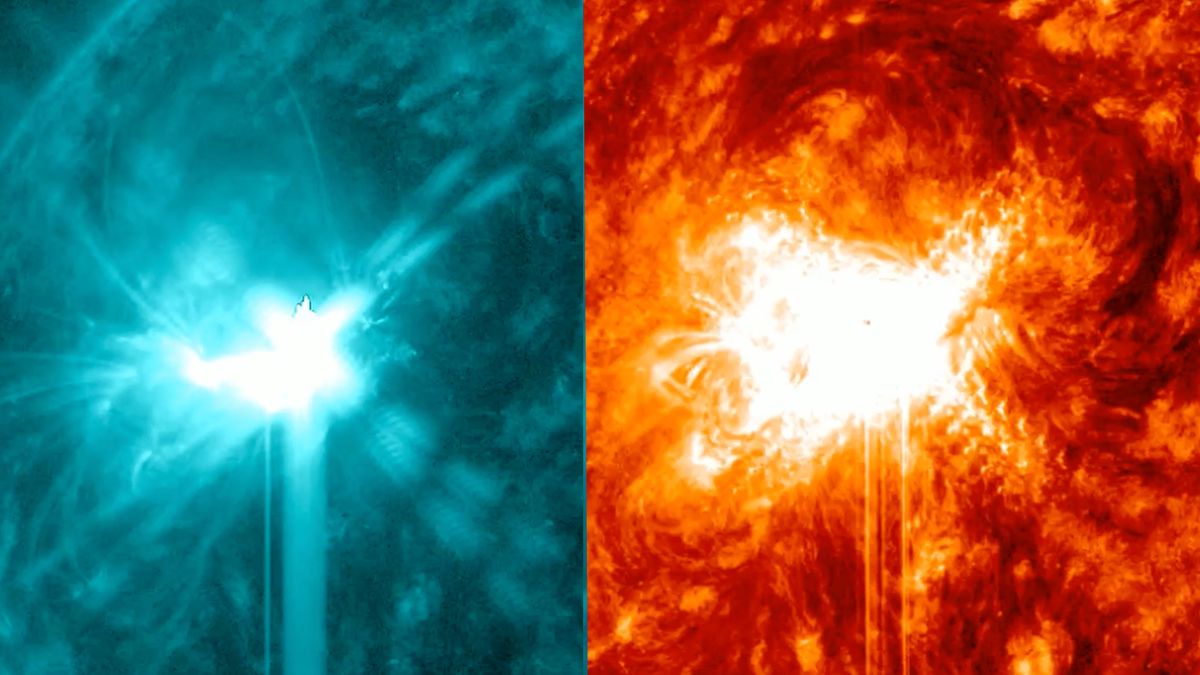
A mysterious widespread cellphone outage has coincided with the eruption of two powerful "X-class" solar flares from a "dangerous" sunspot. Yet scientists warn that the two events are probably unconnected.
The two intense flares burst from the sunspot AR3590 Wednesday (Feb. 21) at 6:07 p.m. ET (23:07 GMT) and Thursday (Feb. 22) at 1:32 a.m. ET (06:32 GMT), according to the National Oceanic and Atmospheric Administration (NOAA).
After traveling to Earth at the speed of light, the flares caused successive shortwave radio frequency blackouts that lasted one or two hours. The first was over the western U.S. and Pacific Ocean, and the second was over the Indian Ocean.
Related: Watch the 1st X-class solar flare of 2024 erupt from the sun in explosive fashion
Hours later at 11a.m. ET (16:00 GMT) , multiple cellular providers — including AT&T, Verizon and T-Mobile — reported disruption to their service across the U.S. for over 70,000 users, according to the disruption tracking website Downdetector.com. The lack of forthcoming official explanation caused some news outlets to blame the outage on the flares.
But because many of the coverage drops were experienced primarily by AT&T customers and came much later and further from when and where the flares hit, solar scientists say terrestrial explanations are much more likely sources of the disruption.
"Some people are attributing cell network outages (AT&T, Verizon) in the U.S to last night's X-class Solar Flare," Ryan French, a solar astrophysicist at the National Solar Observatory, wrote on X, formerly called Twitter. "However, flares only cause radio degradation on the dayside of the Earth. As you can see below, the U.S was not affected by the event. So it's just a coincidence!"
"While solar flares can affect communication systems, radar, and the Global Positioning System, based on the intensity of the eruption and associated phenomena, it is highly unlikely that these flares contributed to the widely reported cellular network outages," NOAA's space weather prediction center wrote in a statement.
The sun is a gigantic ball of plasma whose charged ions swirl over its surface to create powerful magnetic fields. As magnetic-field lines cannot cross each other, sometimes these fields knot before suddenly snapping to launch bursts of radiation called solar flares or enormous plumes of solar material called coronal mass ejections into space.
NOAA classifies solar flares on a five-level scale (A, B, C, M and X) based on the intensity of the X-rays they release, with each level having 10 times the intensity of the last. The two flares were registered as X1.7 and X1.8, making them very intense.
Once they arrived at Earth, the X-rays and ultraviolet radiation produced by the flares ionized atoms in the upper atmosphere, making it impossible to bounce high-frequency radio waves from them and creating a radio blackout. Radio blackouts occur over the areas lit by the sun during the time of the flare and last one or two hours.
While no official statement has been made about what caused the outages, some have speculated it may have been caused by a problem with the cloud services primarily used by AT&T.
"The most likely cause is a cloud misconfiguration," Lee McKnight, an associate professor in the iSchool at Syracuse University, told TechRadar. "Which is a fancy word for saying human error. I was reviewing this exact issue in class yesterday."
Solar activity, which rises and falls according to a roughly 11-year cycle, has been especially high recently, with sunspot counts nearly doubling those predicted by NOAA.
The increased activity has sent waves of high-energy plasma and X-ray bursts slamming into Earth's magnetic field, downing satellites, triggering radio blackouts and causing auroras as far south as Pennsylvania, Iowa and Oregon.
And the most intense activity may still lie ahead. The sun's activity is projected to climb steadily, reaching an overall maximum in 2025, before decreasing again. However, some scientists have suggested that the intense waves of solar eruption could mean that the maximum is already here.







